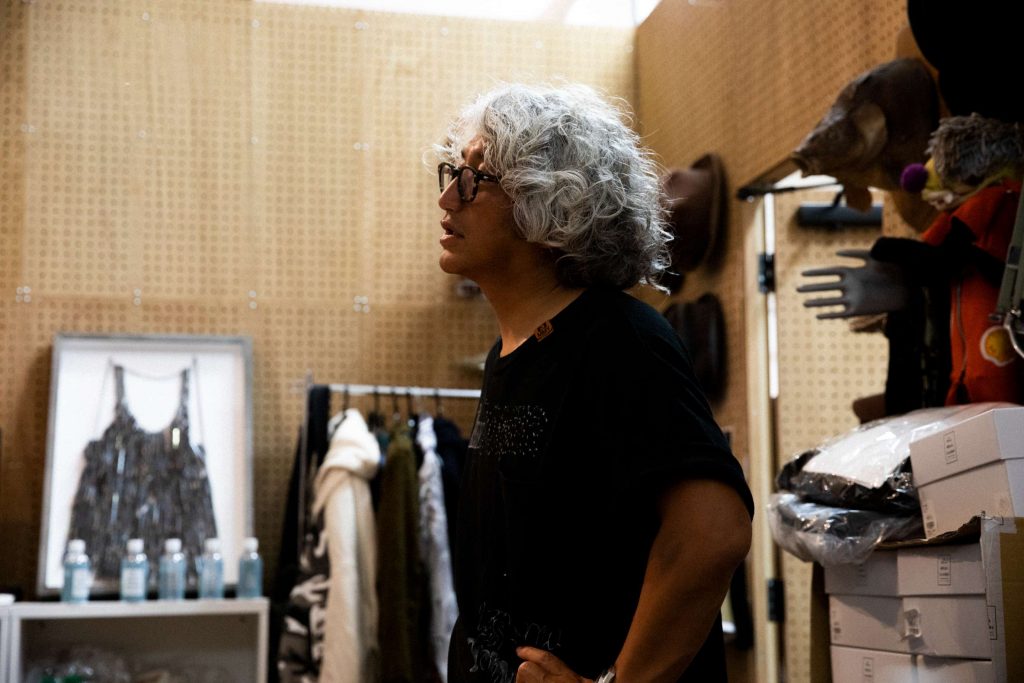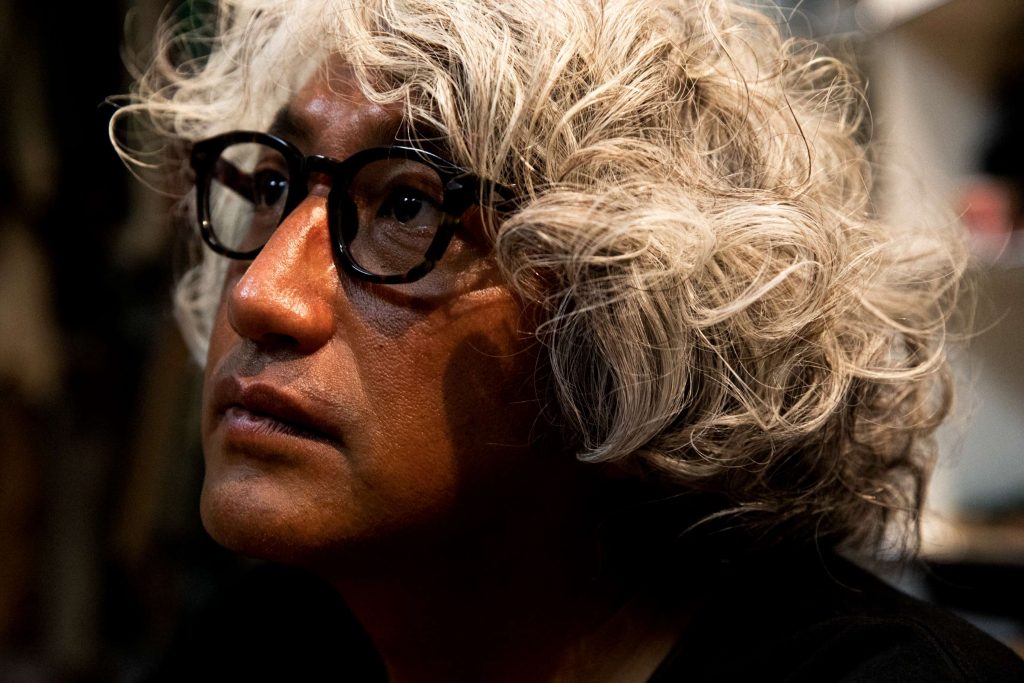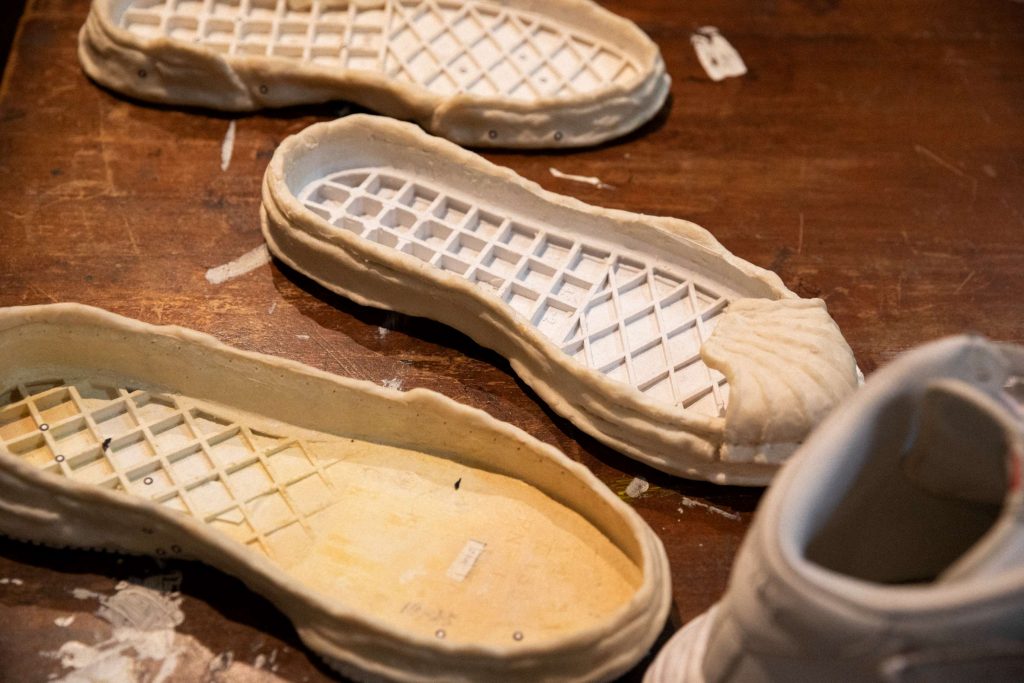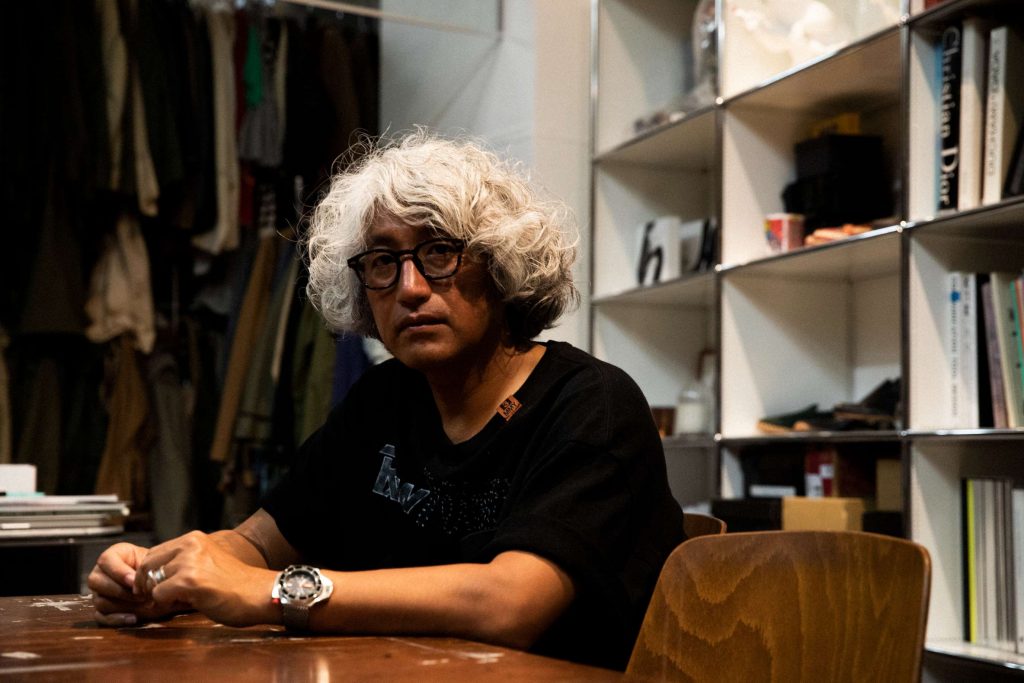Yasuhiro Mihara, a Philosophy of Shoe Designer

Edit & Text by Yukihisa Takei (HONEYEE.COM) Photography by Kiyotaka Hatanaka (UM) Movie Directed by Ryoji Kamiyama
The iconic Maison MIHARA YASUHIRO's sneakers are now attracting attention. With a seemingly randomly deformed sole and an upper that follows the design of an authentic sneaker, these shoes look normal but are anything but normal, giving off a somewhat unbalanced appeal that is slowly gaining more and more fans. HONEYEE.COM conducted a long interview with the designer, Yasuhiro Mihara. We asked him about the background behind the creation of those shoes and where he stands at the moment as a shoe designer and fashion designer.
Is There Such a Thing As ‘Sneaker Culture’?
I'd like to ask you about the background of the sneakers, but can I ask you to go back a bit?
Mihara (M): I founded the brand in 1996 when I was in my third year of college. It's been more than a quarter of a century. Then, in 2000, I started collaborating with PUMA. That lasted for 15 years until 2015. I need to go back that far to talk about these sneakers.
You collaborated with a global brand just four years after your/the launch, and you had a long relationship with them?
M: At the time, the idea of a "nameless designer from the Far East" and a global sports brand working together had a big impact on fashion industry. I enjoyed the chemistry between us, but as I worked on the project for many years, I started to hear more and more about things on the sales side, and I became mentally exhausted. Since 2015, I decided to take a break from sports brands and sneakers. I also have a few regrets.
When you say regret, what do you mean?
M: Nowadays, we live in a world with full of information, such as the "sneaker wars" between major sports brands. At that time, I was the one who encouraged the collaboration between sports brands and fashion, which led to the fashionization of sports brands. Of course, I'm not the only one to be blame for this. 2010 was around the time everyone started calling it "sneaker culture," but I wondered if it was a culture at all. It didn't feel like a culture, at least not to me. I thought this was just for marketing.
Sneakers have become a big business now?
M: Yes, it is. There is a book called “Homo Ludens” written by a Dutch historian named Johan Huizinga (1872-1945) that influenced me when I was a student. The book summarizes that ‘there is always play before culture’, and I was very interested in that when I was young. So, I was interested in how much I could play with sneakers, which were becoming a part of the culture at the time, within the sports brand PUMA, but I felt that the whole sneaker industry was gradually being twisted by marketing and business.
Play Element Changes the World

Did you feel like you were getting sick of sneakers at that time?
M: But, you know, I like them. I like all brands of sneakers. I've never hated sneakers in my life. I'm always looking for new sneakers, I like heritage sneakers, I've had Converse and Vans for as long as I can remember, and I have many memories of adidas Superstar too. When the first NIKE Air Jordan sneakers came out in the 80s, I was fascinated by the colors I saw for the first time. I have a lot of respect for those sneakers. After taking some time off to look at things more calmly, I realized that I wanted to make sneakers. But I wasn't sure what to do. Then I remembered Johan's book and realized that play is important after all, so I decided to make shoes that looked like something a child would make playing with paper clay (laughs). The starting point of those shoes was to play around with a design that a computer algorithm couldn't do. So, it's a very simple but ironic thing.

Was a reaction to marketing boredom that made you turn your hands to clay?
M: Also, the position of sneakers in sports brands has changed from the concept of sports to branding. To be precise, my own feelings about sneakers are not about sports brands. I've been wearing sneakers since I was a kid, and they're more familiar to me than leather shoes.

Is that why you made sneakers in a different shape than other sports shoes?
M: They're shaped like sneakers, but they're not sports shoes. I just call them footwear. I think it's fine that there are all kinds of footwear. I think that's what (Hiroki) Nakamura-san from visvim and others have done, but I also think it's important to have a degree of freedom in the context of footwear. I think it's important to have a lot of freedom in the context of the language of footwear. I think what's important in culture is that something fun and subtle gradually becomes a movement. why you made sneakers in a different shape than other sports shoes?
The End Will Come One Day When You Are Making What People Are Looking For

M: Actually, it's 50/50. It was a little earlier than I had expected. I also stay away from excessive information including social media and YouTube marketing, and I don't take part in sneaker features on online media as much as possible. This is because, considering the nature of fashion and social media, what's popular will definitely go out of style. The faster something becomes popular, the faster it goes out of fashion. That's the natural order of things, and there's nothing we can do about it. That's why we made it our company slogan to say, "Once it's buzzed, it's over". That's why we didn't intend to grow this fast, and we wanted to have a slow growth period.
You don't want to be consumed by speed, but if there is a saturation point somewhere, would you be willing to stop or continue?
M: I'm more open to being criticized for these shoes, even sneaker freaks would say, "This is unacceptable!". But fortunately or unfortunately, they are warmly received. They may understand why I started my own sneaker production in-house, and that I started with feelings that are difficult to put into a single word. However, at some point, I might have to say, "Let's stop". If that were to happen, it would probably be ...... "That's simply because I'm bored". I think you stop doing things when they are no longer interesting. The job of creation comes to an end when you are just making what people are looking for. I believe that a world that fascinates people is a place where you create things even if people are not looking for them.
Child's Play with Precision

Are the MIHARA sneakers made in Japan?
M: No, it's mostly made in China now. Sneaker manufacturing is growing in China, and the techniques, machines, and technology from all over the world are gathering there. It's not the same as it used to be just because of the low cost of production.
So that technology has been used to create the very delicate touch of MIHARA's sneakers?
M: I still had to re-do it many times, though. I had to scan a clay prototype, make a resin mock-up, and then convert that into data. But the amount of information processing is much greater than regular sneakers, so people who make sneakers for other companies say that they don't understand how we do it. , so people who make sneakers for other companies say that they don't understand how we do it. That's because it's impossible to make a sneaker by just looking at the data.
It would not have been achieved without your artisan element, wouldn't it?
M: I make details and also leave scratches that something not logical. I'm aiming for a touch of coincidence, but actually there is no coincidence at all. I’m very meticulous about it. So it's like child's play, but for adults. I'm playing, but I'm probably doing it in a very calculated way. That's why it's fun to do. There are some things that you get bored of doing, but I think this might be something that becomes more fun as you keep doing it.
Sustainability Is About Designing the Time

You also launched a shoe line called General Scale, which focuses on traceability. Is this one of your answers to recent sustainability issues?
M: It was an experiment to see how far we could really go and how far we could express ourselves within the context of traceability and sustainability. They are made of materials that can be returned to the earth so that there is no burden on the earth even if they are consumed, but what we thought about the most was a timeless design that would not be an option to get rid of. When you see a pair of worn-out sneakers at a second-hand store, you may think, "I like those. Then, I thought, what if I try to do this with new ones?
Is the idea that timeless design is the key to sustainability?
M: Yes. It's like the feeling of designing 10 or 30 years ahead. What I refer to is the degraded form of something from the past, but when I express degradation in the present, that will be in the future. There is a paradox of time there. Somewhere in my mind, I think the word "sustainable" is still just an illusion, and I don't think that "sustainable products" will solve all problems. It is a problem of the whole system of environment, society, and economy, and cannot be solved by solving one problem at a time. I also feel uncomfortable with the fact that it is only an education to consumers as it is now, and is being treated like a trend or selling point. Essentially, consumers can judge products based on whether they are cool or not, and whether they want them or not. I hope that everyone will take it for granted that the products they buy are manufactured in a sustainable way. The major companies are starting to make a big push for sustainable sneakers, but I think the sneaker business has become too big. It will still take time to build a sustainable environmental, social, and economic system.
Shoe Designs from Japan and Asia

Do you have the desire to "bring out sneakers from Asia"? Most sneakers come from the US and Europe.
M: You just asked the hard part. I didn't want to tell this, but actually, I do. When I started my brand in 1996, everyone said, "I don't want to wear made-in-Japan shoes". You wouldn't believe it now, would you? I was in my third year of college, and I was hurt by the circumstances, and I knew I couldn't live with that sense of value. I had to smash them up. So I still have that feeling. And when I went to Italy or other European countries, people would ask me, "Why would a young Japanese man like you want to make leather shoes?". But one day, I realized that all the brands say, "Our shoes are authentic and craftsmanship," as if they’re selling point but I thought there is no context of innovativeness there. However, the shoemakers more than 100 years ago, before it became a tradition, must have always had the enthusiasm to create new techniques. With this in mind, I knocked on the door of PUMA. I wanted to follow in the footsteps of the original craftsman in the world of sneakers, which is evolving with the times and technology. Because I love leather shoes, I wanted to become familiar with the world of sneakers as well.
So that's how it happened.
M: But people from overseas were following what I was doing. Some of those kids who were in middle school at the time are now working for major shoe brands. So when I went to a sneaker freaks’ event overseas, they called me "Sneaker God!" (laughs), and they asked me to shake my hand, which made me happy. I think that there will be more shoe designers from Asia who will make an impact on the world, and the number of such designers is actually increasing. It doesn't matter where you come from, as long as you have creativity and passion.
In your case, you also have a position as a fashion designer?
M: I come from an industry where shoe design is looked down upon as the bottom line. Some people often think that shoe designers are less important than fashion designers, or that they are "designers of accessories”. Bags and hats designers are also treated as such, and fashion designers are considered to be superior. That's why I'm often called a "fashion designer" in my title, but I still think of myself as a shoe designer and a shoe designer who makes clothes. The reason why I started designing clothes was to raise the profile of shoe designers. However, at first I was told, "You should just make shoes", and even other shoe designers told me, "You betrayed us and went into fashion”.

That's a harsh word.
M: That was not what I had in mind. I started my business with the intention of fighting on the same ground to raise the position of shoe designers, but the shoe industry treated me like a back-stabber, and people in fashion industry said, ‘You shouldn't have done that’. I think I was most troubled in my late twenties when I was thrown those words.
Now, Maison MIHARA YASUHIRO is definitely recognized as a fashion statement, isn't it?
M: The next thing I know, I'm in the Milan Collection or the Paris Collection. But deep down in my heart, I'm thinking to myself, ‘This wasn't supposed to happen. I wasn't supposed to go that far’. I thought I could just do a little bit of making clothing and then go back to shoes. However, this is no longer the case, and I am now taking my work more seriously than a clothing designer.
The Relationship Between Maison MIHARA YASUHIRO and Tokyo Fashion

When it comes to Japanese fashion that has become internationally renowned, the next generation after COMME des GARÇONS, Yohji Yamamoto, ISSEY MIYAKE are the ‘Ura-Harajuku’ brands, which are close to your generation. I'm wondering how you saw the scene.
M: Like me, the people from “Urahara” didn't go through the process of training at a maison brand before becoming an independent designer. I’m also one of them but we all came out of nowhere and outside the traditional rules. As a result, these people changed many things. "Urahara" is defined as a style today, but the definition is being vague now and there were many more styles of fashion in Tokyo. Each one of us was doing whatever we wanted. I felt like I existed within that corner of the world. Looking at Tokyo from the outside, it's all one city, but there were so many different talents.
When it comes to Japanese fashion, people tend to focus only on the “Urahara".
M: I don't think that's a bad thing.Although we don't know each other very well, I respect Mr. Shinsuke Takizawa (of NEIGHBORHOOD) who pursues what he likes even in the midst of changing times.
Where do you see yourself in this situation?
M: We Japanese have been blessed in the fashion world. Rei Kawakubo, Yohji-san (Yamamoto), and Issey-san (Miyake) opened up the fashion world to us, so we were somewhat privileged. When I was in my twenties, I used to think, "I don't care what designers over fifty are thinking," but I will be fifty next year. But now that I'm in this generation, I feel like I have to work harder (laughs). I think it's important to have that "bump on the eye" part. I also think that I have to enjoy myself. It makes me happy to see the older generation enjoying themselves (laughs).
On the other hand, what do you think about the Japanese shoe designers from younger generation?
M: Both me and (Toshinosuke) Takegahara from foot the coacher came from a leather shoe background and are close in age, so I feel like he’s my younger brother, but I was happy when Hender Scheme came out. I've been interested in shoes having an artistic quality since my beginning career, so I'm very happy to see such designers coming out.
Lastly, what do you think about your future?
M: I'll be 50 years old next year. I feel like I've been taking things too seriously, so I'm thinking, ‘I just have to have fun’. But at the same time, I want to keep on growing. I've been in this industry for more than 25 years, but my desire to keep growing has not changed. I don't want to always be in a period of success, I want to always be in a period of constant growth.

Yasuhiro Mihara
Shoe Designer / Fashion Designer
Born in 1972. With the support of a shoe company, he launched his original brand, 'arch doom' in 1996. In 1997, he launched his own label, MIHARAYASUHIRO, and in 2000, he started a collaboration line with PUMA, PUMA by MIHARAYASUHIRO. He changed his brand name to Maison MIHARA YASUHIRO from the 2016-2017 AW season.
[Editor's note]
This long interview is the first piece of the relaunched HONEYEE.COM. Mihara-san not only graciously accepted our request for the interview, but also took time out of his precious time to answer our questions for hours. I titled the interview "Philosophy of a Shoe Designer" because I felt that his thoughts on shoe design from Japan over the years, his designs against trends, and his ideas were all philosophical. In fact, I would have liked to have asked him about the area of clothing making as well, but this time I got so many words about shoes alone that I couldn't write them down here, so I have edited them to condense their essence. I would also like to write more about Maison MIHARA YASUHIRO's clothing production in the future.